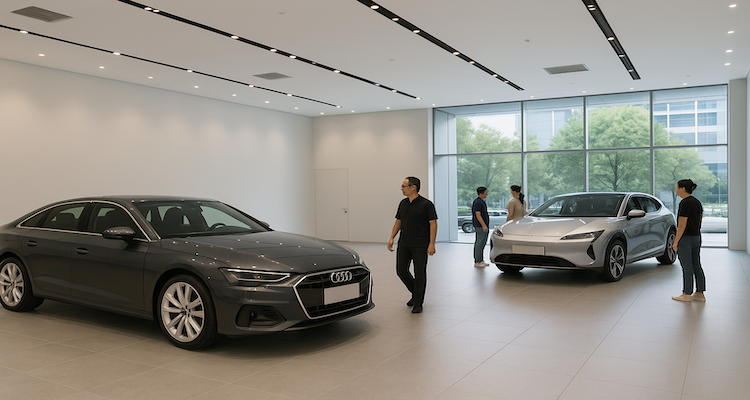Global Automakers Turn to China for an EV Edge
Global automakers from Audi to Renault are tapping Chinese EV technology to speed development. A win-win strategy, but one that risks brand identity.
Introduction: A Wake-Up Call from China
In 2021, when Audi executives first laid eyes on the sleek Zeekr 001, a long-range Chinese electric vehicle with sharp European-inspired design, it triggered an uncomfortable realization. To keep pace in the world’s fastest-growing EV market, German luxury brands would need more than heritage and engineering prestige. They would need Chinese technology.
“It was a shock for everyone,” admitted Stefan Poetzl, president of SAIC Audi Sales and Marketing. “We had to act.”
That moment of reckoning pushed Audi to launch the AUDI E5 Sportback, a new EV tailored for Chinese consumers and built in record time just 18 months, by leveraging its partner SAIC’s expertise in batteries, powertrains, and software.
Why Western Automakers Are Turning East
Audi’s rapid rollout isn’t an isolated case. Global rivals are increasingly leaning on Chinese partners to speed up EV development:
-
Volkswagen has teamed up with Xpeng to co-develop software-driven platforms for China-specific models.
-
Toyota is working with GAC on joint EV projects.
-
Renault and Ford are exploring building global models on Chinese-designed EV platforms, marking a significant shift in strategy.
These partnerships aren’t just about cost savings, they’re survival strategies. Traditional automakers face mounting pressure from Chinese brands that are faster, cheaper, and technologically agile.
A Win-Win in a High-Stakes Market
For Chinese EV makers, the timing couldn’t be better. At home, they face a punishing price war and intensifying global trade tensions. Licensing technology to global carmakers provides a much-needed revenue stream.
“It’s a very smart, win-win solution,” said Will Wang, general manager at Shanghai-based consultancy Autodatas.
The approach has even been likened to the “Intel Inside” model of the 1990s, where Intel chips became the premium selling point for personal computers. Now, Chinese automakers are effectively offering “EVs in a box” ready-made chassis, batteries, and software that allow foreign brands to leapfrog years of R&D.
Chinese Platforms Go Global
Several deals already illustrate this trend:
-
Leapmotor struck a partnership with Stellantis to export Chinese-built EVs while also licensing its technology.
-
Renault’s Dacia Spring EV, sold in Europe since 2021, is built on a Chinese platform from Dongfeng.
-
The upcoming Renault Twingo EV is being developed in Shanghai with support from Chinese engineering firm Launch Design.
-
Ford is scouting Chinese partners for future EV platforms, with CEO Jim Farley openly praising Xiaomi’s SU7 sedan.
Meanwhile, Volkswagen hopes that Xpeng’s software architecture can inject agility into its famously rigid design process, potentially setting the stage for global application.
Experts Weigh In
Analysts say the appeal is simple: Chinese platforms are modular, scalable, and significantly cheaper to build.
“You can get a much more quality-proof product to market in a shorter timeframe,” said Marco Santino, analyst at Oliver Wyman.
Forest Tu, a former CATL executive, noted that Chinese EV makers were quick learners from Tesla, building flexible platforms that now underpin licensing deals. CATL itself has already licensed battery technology to Ford for a U.S. plant.
Broader Implications: From Abu Dhabi to Europe
The impact of this technology export stretches beyond Western carmakers.
-
Abu Dhabi’s CYVN Holdings, a major investor in Nio, is developing its own EVs using Chinese chassis and software, even integrating them into the iconic McLaren brand after acquiring the British automaker earlier this year.
-
CATL’s Bedrock Chassis, unveiled in Europe at the Munich IAA Mobility show, promises to let consumers choose EV designs rather than having them dictated by manufacturers.
This democratization of EV technology could empower smaller or less-industrialized countries to launch their own “national EV brands.”
Risks of Over-Reliance
Yet not everyone is convinced this strategy is sustainable. Former Aston Martin CEO Andy Palmer warned that depending too heavily on third-party technology could erode brand identity.
“In the long run, you risk becoming just a retailer,” Palmer said.
Santino echoed the caution, noting that licensing accelerates development but limits differentiation. Automakers that blend Chinese components with their own innovations will be better positioned to maintain distinct identities.
A New Era of EV Collaboration
The global EV race is no longer just about who can build the best cars, it’s about who can adapt fastest. For legacy automakers, partnering with Chinese firms offers speed and survival in an increasingly cutthroat market.
But the balancing act will be delicate. The future of the industry may well hinge on whether these collaborations create lasting innovation or simply turn once-iconic carmakers into middlemen for Chinese technology.
Also Read: From $70B to $115B: How EEPC India is Shaping the Future of Engineering Exports











